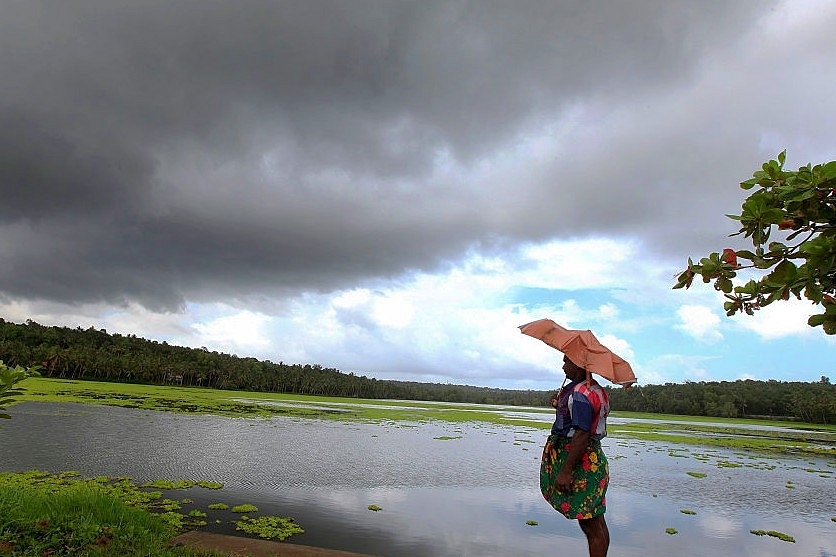News Brief
Excess Rainfall, Higher Water Storage And Increased Kharif Sowing Set To Aid Rural Economy Revival Further
- According to the IMD, the monsoon has showered six per cent excess rainfall till yesterday (19 July).
- Barring north-west India comprising Gujarat, Rajasthan and Punjab, which has received 16 per cent deficient rainfall, the other parts have received over 10 per cent excess rainfall.

Clouds gathering over a lagoon as the first winds of southwest monsoon hit Kerala. (File photo) (Vivek R Nair/Hindustan Times via Getty Images)
A six per cent excess rainfall during the south-west monsoon so far this year, a 33 per cent higher water storage level than the last 10 years and a 21 per cent increase in Kharif sowing are expected to further buoy rural India that is helping Indian economy bounce back.
“This raised expectation of a good Kharif crop. If the monsoon continues to be good through to September, it should also leave the soil moisture good for the Rabi crop,” said B K Singh, Chairman and Managing Director of B K Weather System.
According to the India Meteorological Department (IMD), the monsoon has showered six per cent excess rainfall till yesterday (19 July). Barring north-west India comprising Gujarat, Rajasthan and Punjab, which has received 16 per cent deficient rainfall, the other parts have received over 10 per cent excess rainfall.
Singh says the monsoon this year will be a little higher than normal with Andhra Pradesh, Tamil Nadu, Karnataka and parts of Madhya Pradesh receiving excess rainfall.
Regions such as Jabalpur, Raipur, Bilaspur, Chhattisgarh and east Madhya Pradesh could receive lower rainfall.
This has resulted in the water storage level in the 123 major reservoirs in the country increasing by 50 per cent compared with last year and 33 per cent compared with the last 10 years' average.
The excess rainfall and improved water storage capacity have, in turn, led to a higher acreage in Kharif sowing. According to the Ministry of Agriculture and Farmers’ Welfare, 69.18 million hectares (mh) have been brought under Kharif crops till 17 July against 57.08 mh during the same time a year ago.
Oilseeds, pulses, paddy and cotton are the major gainers followed by coarse cereals. Singh expects major gains for paddy crop in view of the growing regions likely to receive bountiful rain.
Rating agency Crisil says the recent hike in minimum support prices for major Kharif crops augurs well for rural incomes, particularly followed by a good Rabi crop.
Singh said that if rainfall continues to be good over the next three months, it could benefit states such as Madhya Pradesh and Maharashtra for the Rabi season too.
According to experts, the current rainfall, water storage and crop sowing data point to rural India continuing to do better than urban India. In fact, they are pointers of rural economy recovering further.
Already rural areas are reporting a bounce-back in the economy with sales of tractors, two-wheelers and cement increasing. Besides, money transfer through electronic systems has also touched new highs.
Rural regions have harvested a bumper Rabi, with a remunerative price for the crops coming as an additional bonus. But for the novel Coronavirus onset in the country, rural India could have reported buoyancy from April itself.
The current revival in the rural economy is expected to extend by a couple of months, by which Kharif crop could be harvested. This will, in turn, result in the revival continuing beyond the year-end.
The revival of the rural economy will help revive the country’s economy as it could help drive up sales of white goods, fast-moving consumer goods and automobiles among others.
The Centre’s various measures under Atmanirbhar Bharat Abhiyan are also expected to add to the uptrend.
Introducing ElectionsHQ + 50 Ground Reports Project
The 2024 elections might seem easy to guess, but there are some important questions that shouldn't be missed.
Do freebies still sway voters? Do people prioritise infrastructure when voting? How will Punjab vote?
The answers to these questions provide great insights into where we, as a country, are headed in the years to come.
Swarajya is starting a project with an aim to do 50 solid ground stories and a smart commentary service on WhatsApp, a one-of-a-kind. We'd love your support during this election season.
Click below to contribute.
Latest